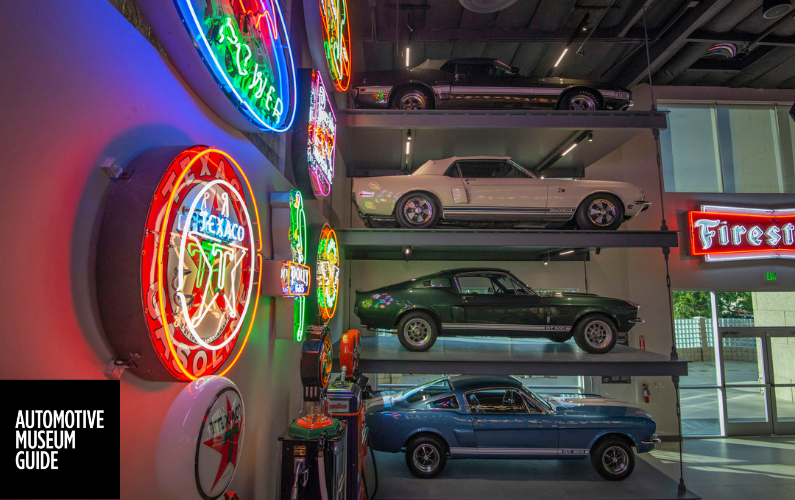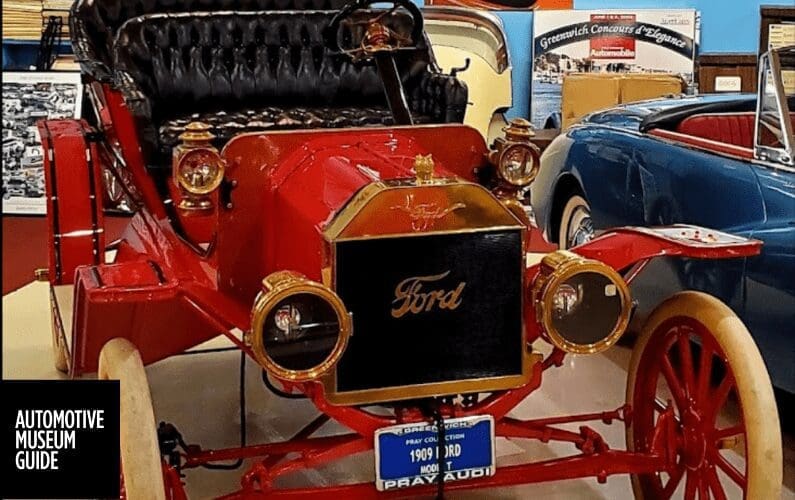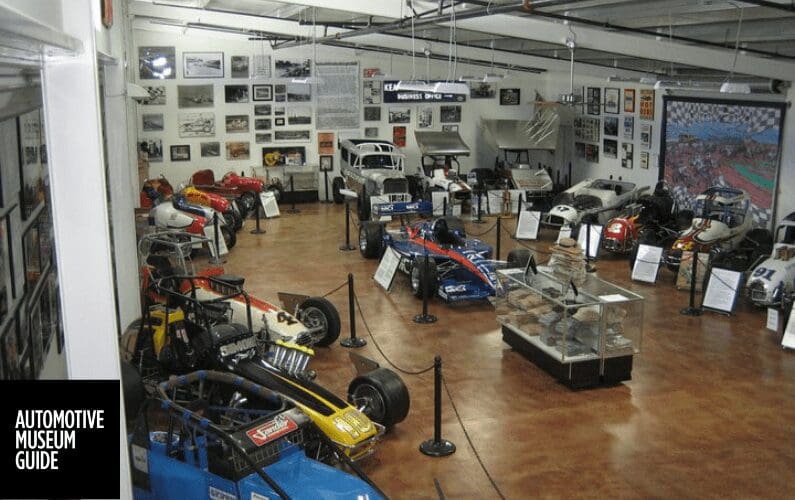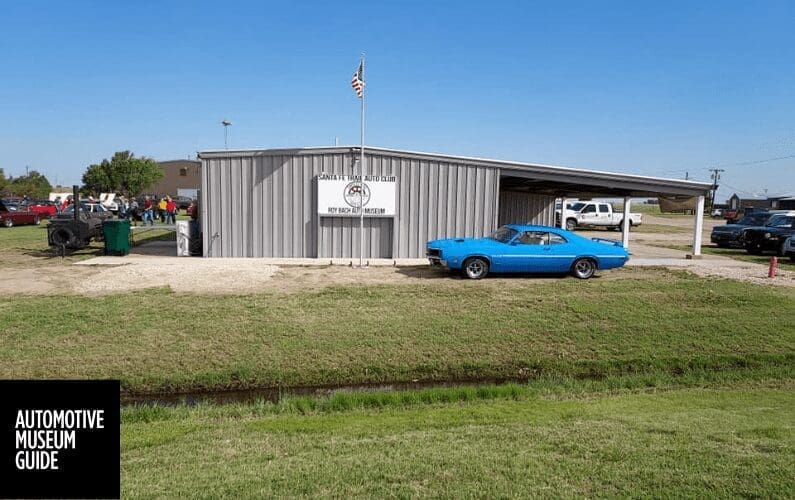You NEED to READ this one!
If you don't care or don't have time to do anything other than just glance at the three automotive museums at the bottom
*READ THIS FIRST SENTENCE*
Please scroll to the bottom of the email to see the three featured automotive museums and where they are.
If you don’t care or don’t have time to do anything other than just glance at the three automotive museums at the bottom of the email to see if you are interested in them or not, that is okay. You can skip all of this.
The fact that you are even opening this email is impressive to me.
Did you know that the average open rate for emails is only 20-30%? Social media is even worse. The average organic reach is less than 10%, depending on the platform.
I suppose I am lucky since at least 50% open this email every week. Most people don’t realize how hard it is to reach your core audience.
Whenever I am at Miles Through Time Automotive Museum, and I am talking to visitors from out of town, I tell them about automotivemuseumguide.com. I assume that if they are enjoying one automotive museum, then they’d like to visit others.
Last Saturday I was mentioning the guide to visitors and one of them already knew about it. This seems to be happening more and more. People are discovering automotive museums all over the country easily with the Automotive Museum Guide, which also helps them plan their trips.
There is also no shortage of people I meet who tell me they get these emails. I say tell, because some read them and others don’t. I get it, most of us are busy and bombarded with spam emails.
You won’t hurt my feelings if you don’t read all of this, but I do hope you take the time to scroll to the bottom and check out the 3 featured automotive museums. Click on each one to learn more about the specific museum, and hopefully it’ll become some place you’ll visit in the future.
Sometimes we don’t have another opportunity. The Soviet Car Museum put up a valiant effort to provide a unique experience for visitors, but sadly, the museum has been permanently closed.
Sergerstrom Shelby has had better luck. This museum and event space opened at the end of 2021 and is still going strong with close to 100 vehicles in their collection. As you can imagine by the name, they have a few Shelbys.
3 Dog Garage opened their doors in 2022 in a 3-story, early 20th century brick building. The building looks amazing and when you add over 100 vehicles in the 75,000-square-foot space, it solidifies the urge to want to visit.
The last museum I want to share is a unique one and an important one. The Malcolm Pray Achievement Center has over 100 years of automotive history on display, but also really emphasizes the discovery of entrepreneurship and success with free guided tours designed to insure the youth.
All automotive museums should be doing that on some level, but for the Malcolm Pray Achievement Center, it is the core of their existence thanks to Malcolm Pray, who sadly passed away in 2013, but his legacy continues on over a decade later.
That’s it for this week. If you want even more automotive museum info, you can join the Automotive Museum Guide Facebook Group HERE. If you want to follow more of my adventures with automotive museums, including Miles Through Time Automotive Museum, my social media links are always at the very bottom of every email.
Until next week.
Have a great week!
SCROLL DOWN TO CHECK OUT THIS WEEK’S 3 AUTOMOTIVE MUSEUMS.
Plan your next trip, discover your new favorite, or find the nearest museum
 Sean Mathis
Sean Mathis
Creator of Automotive Museum Guide
Founder of Miles Through Time Automotive Museum
P.S. Make sure you follow AMG on Facebook and join the FB Group to see what’s going on at all the museums.

3 Dog Garage is a unique, not-for-profit, historic-vehicle museum located in Boyertown, Pennsylvania, and occupies a restored, three-story, early 20th-century brick manufacturing building.

The Segerstrom Shelby Event Center opened in Late Oct 2021. There are antique gas pumps, antique neon signs, Memorabilia of Carroll Shelby, Mustangs, and Shelbys on display.

The Malcolm Pray Achievement Center is located in Bedford, NY, and houses a collection of antique and collectible automobiles spanning over 100 years of automotive history.
If you don't care or don't have time to do anything other than just glance at the three automotive museums at the bottom
May 19, 2025
I created the Automotive Museum Guide six years ago, and today marks the 200th email I sent sharing automotive museums.
May 12, 2025
Last week I shared my vision for the future of Miles Through Time Automotive Museum, which then broke automotivemuseumguide.com. A lot of people reached out to me saying they were not able to access the website.
May 5, 2025
This week I am going to share with you three automotive museums that opened near the same time Miles Through Time Automotive Museum started in 2017.
Apr 28, 2025
The Weekly 3When I was in school, history class was one of my least favorite classes. I don't believe it was because I didn't have any interest in history, considering how involved my life is with history these days. The main memory that sticks out for me about...
Apr 21, 2025
Last week was amazing, getting to spend time with peers and friends at The Petersen. Having the opportunity to view some private collections
Apr 7, 2025
I'm heading to the National Association of Motor Museums' Annual Conference on Tuesday.
Mar 31, 2025
It is pretty awesome when people visit Miles Through Time Automotive Museum from all over the country
Mar 24, 2025
It still amazes me that the Automotive Museum Guide has grown into a huge resource for automotive museums, and visitors who want to visit them.
Mar 16, 2025
I'll start this week by letting you know about a brand-new museum that just opened this month. The St. Charles Motorcycle Museum is now open.
Mar 10, 2025
Klima-Lounge Museo CCC, that is the art, to pair talent and capability, to connect culture and innovation and to create an environment full of generosity, fantasy and technical magic, to find fulfillment in the work and to be able to grow into new dimensions.
Klima-Lounge Museo CCC, that is the visionary concept for the success of our company. We, those who are dedicated to this concept, accept a very special cultural legacy.
Heinrichsburg 1, 88436 Eberhardzell, Germany
P: +4973559332860
E: info@klima-lounge.com
Museo guided tour*2 € 150,00
Adults € 25,00
Children (<14) € 10,00
Children (<6) Free
Parking spraces for cars from € 110,00
Plan: 1+hr
Image via Dr Torjale Ahmad
.
Miles Through Time Automotive Museum has over 100 years of must-see automotive history on display. This unique, co-op-style museum is located inside of Vintage Garage Antiques which is in an old textile mill called the Old Clarkesville Mill in Clarkesville, GA....
AACA Museum, Inc. at Hershey is a professionally staffed, collecting institution presenting semi-permanent and temporary exhibitions. Exhibitions are supported by educational programs for school and community audiences. It sponsors workshops and other activities...
The Cole Land Transportation Museum collects, preserves, and displays (before they disappear forever) a cross-section of Maine's land transportation equipment from which this and future generations will gain knowledge of the past. We also wish to remember, record...
With its creative architecture and great attention to detail, Barber Vintage Motorsports Museum is home to over 1,400 motorcycles that span over 100 years of production. More than 650 bikes can be seen on any given day, and 200 different manufacturers from 20...
automotive museum guide
Sign up to get updates about automotive museums right to your mailbox. Don't miss a thing. It's FREE.
Learn about North America's Automotive Museums you can visit.
We created the ultimate resource of America's Automotive Museums.
It’s amazing how much time can just become a blur. I started Miles Through Time Automotive Museum eight years ago. I created the Automotive Museum Guide six years ago, and today marks the 200th email I sent sharing automotive museums.
This means I have shared over 600 automotive museums in just under four years. Some people have been following along from the very beginning, while over 100 new people join every single month.
Someone new to the Automotive Museum Guide may not realize the guide exists because it started as my research to figure out how to create my own car museum.
Once someone realizes I founded a museum myself called Miles Through Time Automotive Museum. The assumptions about me can run wild. Some of them I wish were true, but usually they are way off base.
I am an open book. It is the only way I found I could create a web of automotive museums and get people to be a part of my museum. If you’re on Facebook, Instagram, LinkedIn or X, you can follow me directly.
I’m not independently or generationally wealthy. I’m just a car guy who inherited his grandpa’s 1959 Cadillac and felt so honored to have it, that I wanted to share it with as many other people as I could and provide a platform for others like me to do the same.
Luckily, my vision of what an automotive museum could be has morphed over the years and has had success. It is amazing when I get emails out of the blue that someone wants to donate a vehicle. Or I check the mail or get an email notification that someone has sent a check or donated online.
There are a lot of passionate automotive enthusiasts in the world, and the fact that you get this email means you’re one of them. The museum I started is just one of many automotive museums you can visit, and I hope you are able to visit as many as possible.
The more I am immersed in the automotive museum world and automotive culture, the stronger my feelings get about how important it is for us to not only preserve and share automotive history, but to learn from it as well.
Automotive museums are just like snowflakes. No two are alike, but they are all beautiful in their own way. You may visit an automotive museum and find it isn’t your favorite for one reason or another, but at least you did your part by visiting, and hopefully you saw something interesting and learned something new.
There is one museum I regret not being able to stop at, especially since I literally drove past the entrance when I was driving a donated car back from California. I was still on east coast time and eager to drive back, so when I drove past Woodland Auto Display it was 4 am.
I will be back at some point though, because I want to see the museum Dick Woodland founded and explore Estrella Warbird Museum at the same time.
Another museum you can visit that blurs the line between auto and air is the Old Rhinebeck Aerodome. I’m a fan of seeing vintage planes and cars together, which is exactly what you will see at this museum.
The last museum I want to share with you this week is an example of a basic automotive museum. The Roy Peter Bach Museum is operated by the Santa Fe Trail Auto Club. There is very little information available about this museum, but it is open to the public on Tuesdays and Thursdays. Sometimes you just have to start somewhere.
There are so many automotive museums to discover, the best resource to use when traveling the country is the MAP. If you’re a world traveler, there is even more to discover HERE.
If you know anyone who would enjoy learning about automotive museums to visit, forward this email over to them and encourage them to sign up.
Have a great week!
SCROLL DOWN TO CHECK OUT THIS WEEK’S 3 AUTOMOTIVE MUSEUMS.
Plan your next trip, discover your new favorite, or find the nearest museum
 Sean Mathis
Sean Mathis
Creator of Automotive Museum Guide
Founder of Miles Through Time Automotive Museum
P.S. Make sure you follow AMG on Facebook and join the FB Group to see what’s going on at all the museums.

Founded by vintner and car aficionado Richard “Dick” Woodland, the collection also includes numerous well-known vintage and classic automobiles, along with preserved historical motorcycles.

Roy Peter Bach Auto Museum is a new auto museum with vintage and antique automobiles and other auto collectibles.

The Old Rhinebeck Aerodrome all begins in the Pioneer Building with the crude biplane hang gliders that inspired the Wright Brothers.
If you don't care or don't have time to do anything other than just glance at the three automotive museums at the bottom
May 19, 2025
I created the Automotive Museum Guide six years ago, and today marks the 200th email I sent sharing automotive museums.
May 12, 2025
Last week I shared my vision for the future of Miles Through Time Automotive Museum, which then broke automotivemuseumguide.com. A lot of people reached out to me saying they were not able to access the website.
May 5, 2025
This week I am going to share with you three automotive museums that opened near the same time Miles Through Time Automotive Museum started in 2017.
Apr 28, 2025
The Weekly 3When I was in school, history class was one of my least favorite classes. I don't believe it was because I didn't have any interest in history, considering how involved my life is with history these days. The main memory that sticks out for me about...
Apr 21, 2025
Last week was amazing, getting to spend time with peers and friends at The Petersen. Having the opportunity to view some private collections
Apr 7, 2025
I'm heading to the National Association of Motor Museums' Annual Conference on Tuesday.
Mar 31, 2025
It is pretty awesome when people visit Miles Through Time Automotive Museum from all over the country
Mar 24, 2025
It still amazes me that the Automotive Museum Guide has grown into a huge resource for automotive museums, and visitors who want to visit them.
Mar 16, 2025
I'll start this week by letting you know about a brand-new museum that just opened this month. The St. Charles Motorcycle Museum is now open.
Mar 10, 2025
3 Dog Garage is a unique, not-for-profit, historic-vehicle museum located in Boyertown, Pennsylvania, and occupies a restored, three-story, early 20th-century brick manufacturing building with an attached one-story wing built approximately 50 years ago. A second building, within easy walking distance of the first, is a recently and extensively renovated mid-20th century brick manufacturing facility, which opened its doors as a museum in 2022. Display areas, a working restoration shop, a library and other spaces, all combined, total approximately 75,000 square feet.
The several collections in the museum contain vehicles as chosen by long-time collector Ross Myers, who bought his first vintage automobile, a 1936 Ford in need of total restoration, when he was eight years old. The car is now a national-award winning show car and resides at 3 Dog Garage with more than 100 other vehicles.
The museum takes its name from three Myers family dogs, all of whom enjoyed going for rides in old cars, especially old open cars. Their names were George, Gracie and Dauber, all Bouviers, now in Dog Heaven.
Ross and his wife Beth have designed the museum spaces so that the visitor experience provides the opportunity for close personal inspection and enjoyment of the vehicles without ropes or encumbrances to easy movement. There is no charge to visit 3 Dog Garage, but admission can be made by pre-arrangement with the museum scheduling department for groups such as car clubs or community service organizations.
15 S Madison St.
Boyertown, PA 19512
Free
Plan: 1+hr
Image via Chris Marcho
.
Miles Through Time Automotive Museum has over 100 years of must-see automotive history on display. This unique, co-op-style museum is located inside of Vintage Garage Antiques which is in an old textile mill called the Old Clarkesville Mill in Clarkesville, GA....
AACA Museum, Inc. at Hershey is a professionally staffed, collecting institution presenting semi-permanent and temporary exhibitions. Exhibitions are supported by educational programs for school and community audiences. It sponsors workshops and other activities...
The Cole Land Transportation Museum collects, preserves, and displays (before they disappear forever) a cross-section of Maine's land transportation equipment from which this and future generations will gain knowledge of the past. We also wish to remember, record...
With its creative architecture and great attention to detail, Barber Vintage Motorsports Museum is home to over 1,400 motorcycles that span over 100 years of production. More than 650 bikes can be seen on any given day, and 200 different manufacturers from 20...
automotive museum guide
Sign up to get updates about automotive museums right to your mailbox. Don't miss a thing. It's FREE.
Learn about North America's Automotive Museums you can visit.
We created the ultimate resource of America's Automotive Museums.
The museum’s primary focus is racing vehicles, with a concentration of NASCAR Sprint, Modified, Super Modified, and Midget race cars. Founded by vintner and car aficionado Richard “Dick” Woodland, the collection also includes numerous well-known vintage and classic automobiles, along with preserved historical motorcycles. The Woodland Auto Display is located on the grounds of the Estrella Warbirds Museum. It is home to a vast collection of military artifacts, aircraft, vehicles, and memorabilia.
4251 Dry Creek Rd
Paso Robles, CA 93446
P: 805-238-9317
Email: woodlandautodisplay@gmail.com
Entrance to both museums is through the Gift Shop at Estrella Warbirds Museum. Admission (includes entrance to both Estrella Warbirds Museum and Woodland Auto Display):
One Day/ Pass Two Day Pass
Adult $18 / $24
Senior (60+) $12 / $24
Student (w/ID) $10 / $15
Child (6-12) $8 / $12
Child (0-5) Free / Free
Military Veteran $12 / $18
Active Duty (w/ID) Free / Free
Plan: 2+hr
Thursday – Sunday 10am – 4pm
Image via https://www.facebook.com/woodlandautodisplay/
.
Miles Through Time Automotive Museum has over 100 years of must-see automotive history on display. This unique, co-op-style museum is located inside of Vintage Garage Antiques which is in an old textile mill called the Old Clarkesville Mill in Clarkesville, GA....
AACA Museum, Inc. at Hershey is a professionally staffed, collecting institution presenting semi-permanent and temporary exhibitions. Exhibitions are supported by educational programs for school and community audiences. It sponsors workshops and other activities...
The Cole Land Transportation Museum collects, preserves, and displays (before they disappear forever) a cross-section of Maine's land transportation equipment from which this and future generations will gain knowledge of the past. We also wish to remember, record...
With its creative architecture and great attention to detail, Barber Vintage Motorsports Museum is home to over 1,400 motorcycles that span over 100 years of production. More than 650 bikes can be seen on any given day, and 200 different manufacturers from 20...
automotive museum guide
Sign up to get updates about automotive museums right to your mailbox. Don't miss a thing. It's FREE.
Learn about North America's Automotive Museums you can visit.
We created the ultimate resource of America's Automotive Museums.